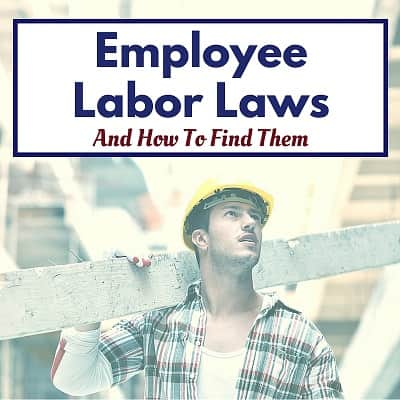Employee Labor Laws and How to Find Them

Workers in the United States are protected by hundreds of federal labor laws. This legislation covers a broad range of topics, including wages, workplace safety, breaks and discrimination.
It's critical for workers and employers to understand and follow labor laws, especially when it comes to safety and health on the job. When workers violate OSHA laws and regulations, serious accidents and deaths can occur. When employers break labor laws, they face massive fines. The penalties can vary depending on the type of violation and severity.
Employers have an obligation to follow all applicable labor laws. In addition, workers are legally protected from discrimination, losing their job or other retaliation after filing a complaint related to labor law violations.
It can be challenging to keep track of all the labor laws that apply to your workplace. Some laws are mandatory for every employer to follow, while others apply to specific industries or companies over a certain size.
If you're wondering where to look, the answer can vary. Many laws are covered in the Fair Labor Standards Act and the Occupational Safety and Health Act. Various other laws are administered and enforced by the U.S. Department of Labor or the state you work in.
This article provides an overview of some key laws and regulations that workers often ask about.
Employee Lunch Hour
Under the Department of Labor and the Fair Labor Standards Act (FLSA), there are several federal and state regulations pertaining to the rights of workers in addition to the right to a safe and healthful work environment. First, one of the most popular questions revolves around breaks and meal periods. According to the Fair Labor Standards Act, there is no federal requirement for breaks and meal periods. However, some states may have requirements for breaks and meal periods.
For example, your state may require employers to provide a break after you work a certain number of hours. The number of hours you need to work before the break and the required length of the break will vary from state to state.
Keep in mind that state laws for meal and rest breaks can change due to legislative changes, court decisions or other factors. For up-to-date information about break requirements for your state, visit the U.S. Department of Labor pages on minimum meal periods and minimum paid rest periods.
Restroom Breaks
Sanitation standards for restroom breaks are generally covered by OSHA, but mostly by interpretation. OSHA restroom requirements are outlined in the following standards:
- 1910.141 – Sanitation (General Industry)
- 1926.51 – Sanitation (Construction)
- 1928.110 – Field Sanitation (Agriculture)
These standards require employers to provide toilet facilities separate for each sex in all places of employment. For construction and general industry, the number of employees dictates the minimum number of facilities that must be available. Furthermore, employers may not impose unreasonable restrictions on employee use of facilities.
Additional clarification on toilet facility requirements for general industry employers is described in an OSHA interpretation letter for standard number 1910.141(c)(1)(i). OSHA states that "employees will not suffer the adverse health effects that can result if toilets are not available when employees need them."
Hours and Overtime
Federal overtime provisions are found in the Fair Labor Standards Act. So how many hours a week can someone work? According to the FLSA, there is no limit for employees 16 years or older.
Another interesting point workers may not be aware of is that, according to federal laws, an employee can be required to perform duties outside the employee’s job description. This is different for employees under the age of 18.
Overtime pay is another highly searched topic. The FLSA requires overtime pay for nonexempt employees for all hours worked over 40 in a workweek. It does not require overtime pay on Saturdays, Sundays, holidays or regular days of rest (unless overtime is worked on these days).
Some exceptions exist for police, firefighters and employees of hospitals and nursing homes. However, certain states have enacted overtime laws where the employee is subject to both federal and state laws, but the employee is entitled to overtime under the standard providing the higher rate of pay.
Nonexempt versus Exempt
A nonexempt employee is one who is entitled to minimum wage and overtime pay under the FLSA. An exempt employee is one who is exempt from overtime pay and some from both overtime pay and minimum wage provisions. Employers and employees should always closely check the terms and conditions of an exemption in light of the employee's duties.
While exemption status can vary depending on your employment contract, nonexempt employees are typically paid hourly. Exempt employees are paid a salary and often work in professional, administrative or executive roles.
Examples of nonexempt roles that may be eligible for overtime pay include:
- Non-management construction workers
- Carpenters
- Electricians
- Mechanics
- Plumbers
- Iron workers
- Craftsmen
- Operating engineers
- Longshoremen
- Manual laborers
- Other blue collar workers
Examples of exempt roles that may not qualify for overtime include:
- Managers
- Executives
- Administrative employees
- Professional employees
- Computer employees
- Outside sales employees
For more information, see the Department of Labor's fact sheet on exemptions under the FLSA.
Minimum Wage
An employee is generally subject to both the state and federal minimum wage laws, with the higher of the two wages prevailing. Federal minimum wage as of 2009 was $7.25. To find out if your state has a separate minimum wage, click here: http://www.dol.gov/whd/minwage/america.htm
There are many more Labor Law topics of interest to employees and employers, including vacation/sick time, leave and benefits. You can visit the Department of Labor website for a comprehensive list of questions and answers or at least, a point in the right direction. http://webapps.dol.gov/dolfaq/dolfaq.asp
